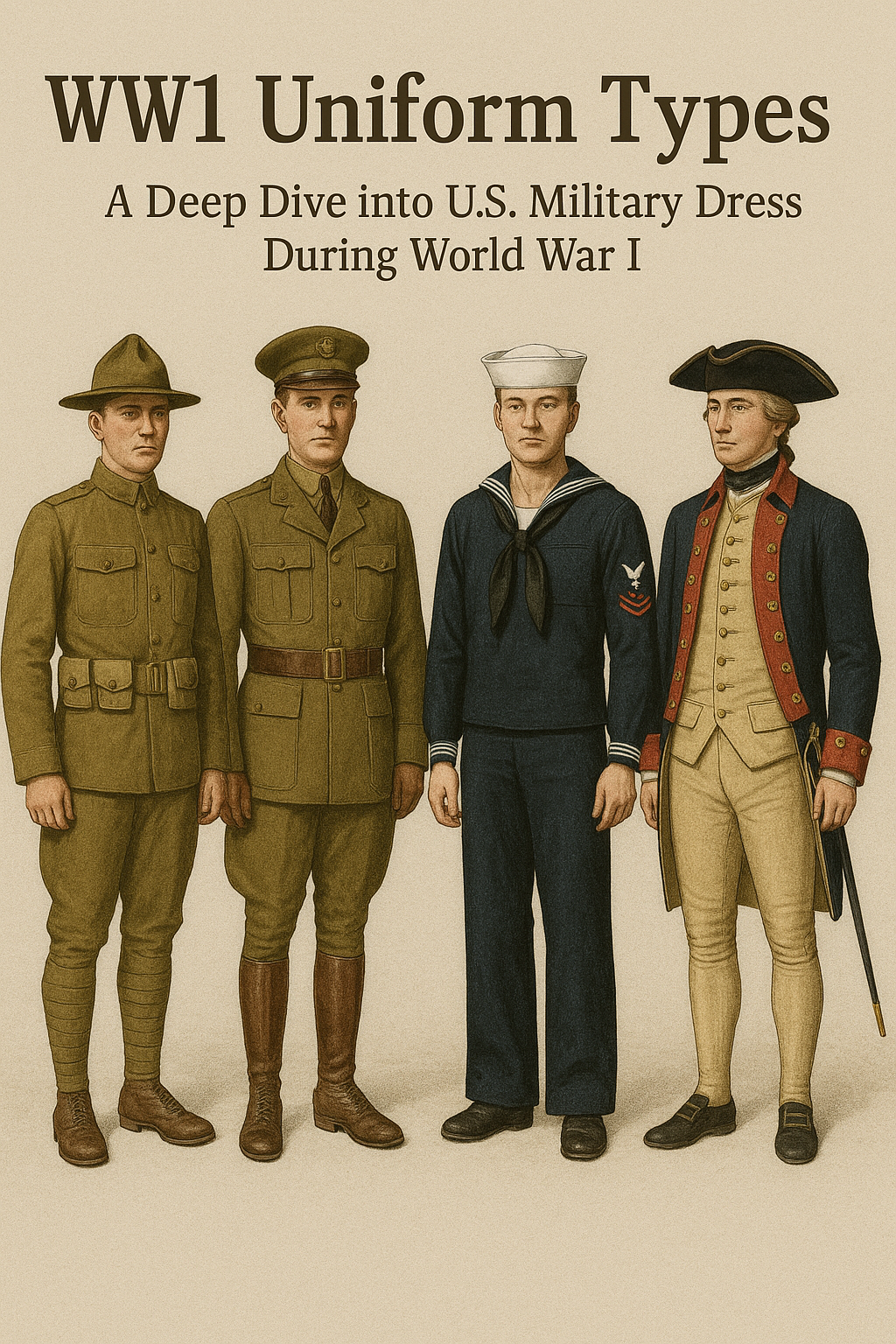
WW1 Uniform Types: A Deep Dive into U.S. Military Dress During World War I
Published on May 06, 2025
WW1 Uniform Types: A Deep Dive into U.S. Military Dress During World War I
Introduction: Why Military Uniforms Tell More Than Just Style
Military uniforms do more than outfit soldiers—they embody national identity, structure, and historical legacy. During World War I, American uniforms evolved from both practical and symbolic needs. From the muddy trenches of France to the decks of U.S. Navy ships, uniforms helped define the soldier’s experience and role. In this article, we explore key WW1 uniform types along with historic influences like the Continental Army uniform and the iconic blue coats of the American Revolution.
1. U.S. Army Uniforms in WW1: Built for the Battlefield
When the United States entered World War I in 1917, its Army uniforms were a blend of early 20th-century tailoring and lessons learned from other global militaries.
Key Components:
- Service Coat (M1910 & M1917): These wool coats featured high collars, epaulettes, and brass buttons stamped with the Great Seal.
- Wool Breeches: Designed to tuck into puttees, these trousers allow flexibility and mobility.
- Puttees or Canvas Leggings: Wrapped around the lower leg to provide support, warmth, and protection from debris.
- Campaign Hat: A wide-brimmed felt hat that shaded soldiers’ eyes and identified them at a glance.
The uniforms were mostly olive drab in colour, chosen to provide some camouflage while keeping a standardized appearance.
2. WW1 Navy Uniforms: Tradition Meets Function
U.S. Navy uniforms during WW1 were heavily based on longstanding naval traditions. Sailors wore uniforms that were functional aboard ships and recognized worldwide.
Navy Garment Details:
- Navy Blue Jumper: The sailor’s classic blouse with a flap collar and white piping.
- Bell-Bottom Pants: Flared to make them easy to roll up, ideal for wet conditions.
- “Dixie Cup” Hat: The white, flat-topped hat worn by enlisted sailors is still seen today.
- Pea Coats: Heavy wool coats offering warmth in harsh ocean climates.
The design of these uniforms emphasized durability and ease of movement, which are particularly critical in shipboard environments.
3. Officer vs. Enlisted Uniforms: Class and Customization
Uniforms in WW1 were not one-size-fits-all—officers and enlisted men had clearly different attire.
- Officers had access to private tailors, resulting in uniforms made with finer materials, and were often allowed to purchase their gear.
- Enlisted Men wore standard-issue gear with simpler detailing.
- Accessories like Sam Browne belts, leather gloves, and custom boots were common among higher-ranking personnel.
These differences were not just aesthetic—they reinforced the chain of command and military hierarchy.
4. Continental Army Uniform: The Origin of American Military Style
The Continental Army uniform dates back to the American Revolutionary War and helped shape the symbolism and style of future U.S. military attire.
Main Features:
- Blue Wool Coats: These became standard after General George Washington chose blue to distinguish American troops from British redcoats.
- Facings in Buff, Red, or White: Depending on region or regiment.
- Waistcoats and Breeches: Usually linen or wool dyed in matching tones.
- Tricorn Hats and Cocked Hats: Common early headgear, later replaced with more functional caps.
Though primitive by today’s standards, these uniforms laid the foundation for visual discipline and military identity.
5. The Blue Coats of the American Revolution: Legacy in Wool
The blue coats of the American Revolution were much more than garments—they were symbols of resistance and national pride. These early uniforms represented the birth of a nation and were designed with both symbolism and practical needs in mind.
Even by the time of World War I, this legacy lingered. Elements like dark blue in dress uniforms and brass buttons were nods to these early military traditions. Collectors today treasure these garments for their rarity and historical value.
6. How WW1 Uniforms Influenced Modern Military Dress
While technology and warfare have drastically changed, the principles behind military uniforms remain consistent.
- The modern Army Combat Uniform (ACU) still values function, durability, and camouflage, echoing the practical innovations of WW1 gear.
- Naval dress uniforms have retained much of the same look, including the traditional “crackerjack” design for sailors.
- Formal attire in the military, including full dress uniforms, still includes insignia, high collars, and sometimes even blue tones—clear descendants of WW1 and Revolutionary styles.
Understanding WW1 uniforms helps explain the lineage of military attire and the reasons behind modern uniform choices.
7. WW1 Uniforms as Collector’s Items and Reenactment Gear
Historical reenactment groups and collectors keep the memory of these uniforms alive. For them, authenticity is key:
- Original insignia and service stripes are highly prized.
- Reproductions are often used for reenactments, especially for garments that are too fragile or rare to wear.
- Historical accuracy in fabric, stitching, and buttons is essential.
Collectors often spend years researching and restoring pieces to ensure accuracy down to the thread.
Conclusion: Stitching Together the Past
From the muddy trenches of World War I to the founding days of the Continental Army, the story of WWI uniform types is more than a tale of cloth and buttons. It’s a visual journey through the evolution of warfare, national pride, and the enduring spirit of American soldiers.
Each garment carries a story—whether it’s a wool tunic that braved a bitter European winter or a sailor’s jumper that crossed oceans. For enthusiasts and historians alike, these uniforms aren’t just relics. They’re living threads of the American military tradition.
